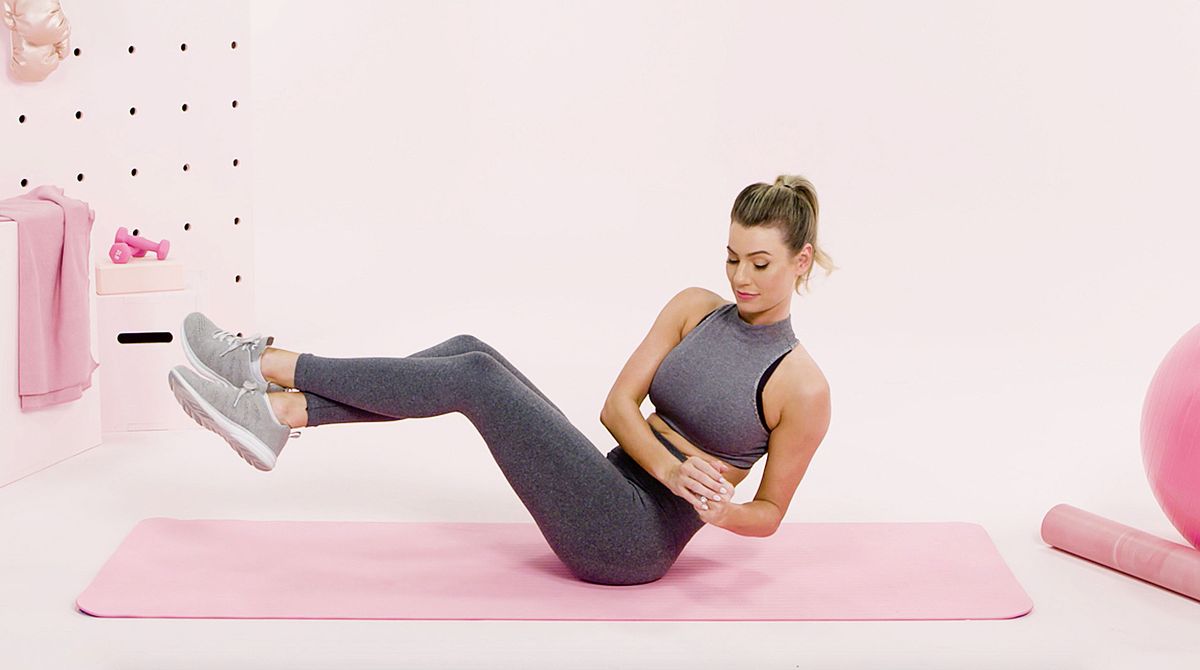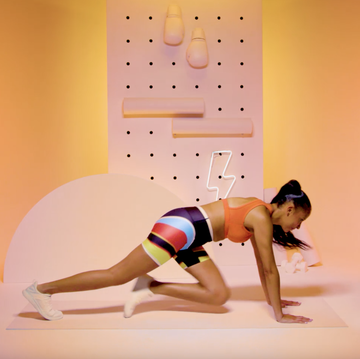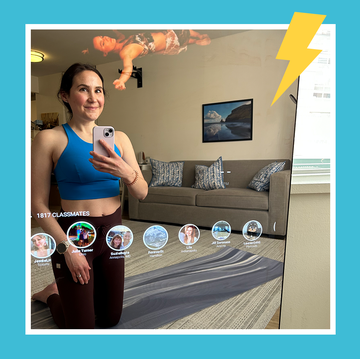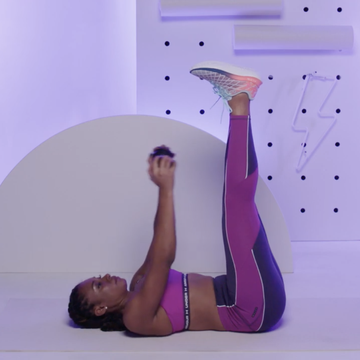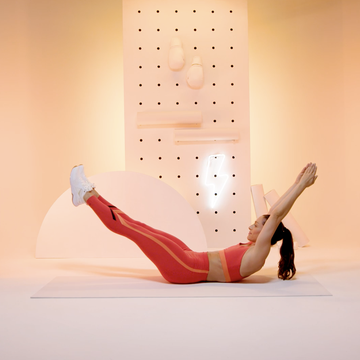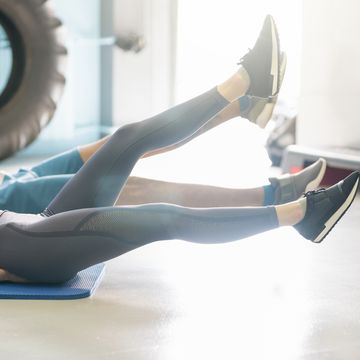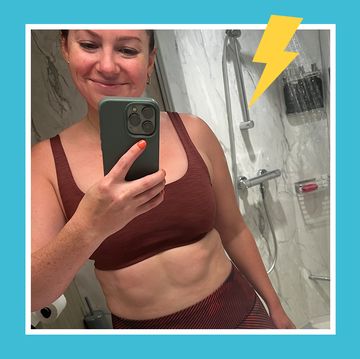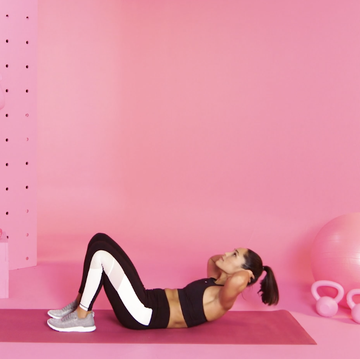Want an exercise that’ll rev up your abs game like a triple Americano boosts your productivity? Russian twists might be a good addition to your regimen.
The standard Russian twist looks something like this: You lean back, raise your legs off the ground, and twist your torso from side to side. The primary target? Your core, of course!
"The Russian twist targets all the muscles in your core, making it a great abs exercise when you’re tight on time," says Peter Donohoe, NASM-certified personal trainer, core strength teacher at the Boston Ballet, and functional performance specialist for Hydrow. It’s especially good for working your obliques (the muscles on the sides of your core), according to Amanda Hudock, ACE-CPT.
More From Women's Health

If you're speeding through a bunch of reps or throwing a huge amount of weight from side to side, you can lose the integrity of the movement that way, Hudock says. You need to prioritize the quality of your reps in order to prevent injury and get stronger.
WH is here to help you with just that. Read on for everything you need to know about Russian twists, including how to do them with great form, where they fit into the bigger picture of core exercise, and how to modify them to scale back or amp up the challenge.
How To Do Russian Twists
How to:
- Sit on the floor and bring your legs out straight.
- Lean back slightly so your torso and legs form a V-like shape, bracing your abdominal wall to engage your core.
- Balancing here and keeping your legs stationary, twist your torso from side to side. (Demo’d by trainer Anna Victoria!) Remember to move slowly and breathe, says Donohoe. Don't disengage your core when fatigue sets in.
Pro Tip: It’s important to move slowly, Hudock explains, rotating through your obliques, upper back, and shoulders while stabilizing and protecting your lower back from strain.
Reps/sets for best results: Aim for two to three sets of 10 to 12.
Benefits Of Russian Twists
Russian twists strengthen your core, obliques, and spine. "It’s a total core exercise that also works your balance, builds stability in your spine, and trims your mid-section all at once," says Donohoe.
- It strengthens and challenges your core. Simply holding yourself up in the starting position for the Russian twist takes a lot of core strength, Hudock says. For that reason, beginners may want to modify the move or master others first.
- It provides a bonus leg workout (and more!). Yup, it’s not just for your obliques. Hudock says this move can work your legs and hips, too.
- It can help you add good variety to your exercise regimen. To understand why, first review the three planes of motion: frontal, sagittal, and transverse. “Frontal is side-to-side [movement], sagittal is forwards and backwards, and transverse is rotation,” Hudock explains. There are lots of exercises that require forward and backward movement (think: crunches), she adds. Russian twists, on the other hand, require you to move in the less common transverse plane.
- The move complements your go-to planks. Basically, this comes back to that rotation you’re doing with Russian twists. Plank variations can be good anti-rotation movements, or exercises that require you to prevent yourself from rotating, Hudock says. “Anti-rotation can help us prevent injuries because we are teaching ourselves how to ‘brace’ and create stable trunks,” she explains. On the other hand, “the benefit of doing rotational movements [like Russian twists] can be increased power,” she says. You’ll want to do both types of movements within a well-rounded core regimen.
Make The Russian Twist Part Of Your Workout
Most people can include this move in their routine two to three times a week, but if your workout of choice relies on rotational strength (i.e., golf, kickboxing), bump that up to four times a week.
The Russian twist can be incorporated into any abs circuit, but Donohoe likes pairing it with an upper body exercise like a chest press, single-arm dumbbell row, or bent over row.
If the standard exercise is too much for your back or hip flexors, switch to your knees with this modification:
- Start kneeling on a mat.
- Lean back to roughly a 60 degree angle (you'll feel where it's stable).
- Twist from side to side. This engages your glutes and core but shortens the range of motion, says Donohoe.
If you want an extra challenge, try adding some weight—a medicine ball or dumbbell will work. But if your hip flexors feel strained—a sign your core is exhausted and no longer engaged—Donohoe recommends ditching the weight and/or lowering your reps.
Are Russian twists good for beginners?
The short answer: not necessarily. Remember how holding yourself in that position requires a lot of core strength? If you aren’t quite there yet, Hudock recommends mastering stabilizing exercises like planks or dead bugs first.
And when you are ready to try out the Russian twist, start with a modified, bodyweight-only version of the exercise. Keep your heels on the ground, Hudock suggests, and just do a low number of reps. You can even start by holding yourself in that starting position—when you feel ready, add in that controlled rotation.
(Note: Hudock actually advises keeping your feet on the ground for stability—and in order to isolate the core—even while doing more advanced variations of the Russian twist.)
How To Level Up Russian Twists
If you want an extra challenge, try adding some weight—a medicine ball or dumbbell will work. But start light and make sure you’re in control, Hudock notes. And if your hip flexors feel strained—a sign your core is exhausted and no longer engaged—Donohoe recommends ditching the weight and/or lowering your reps.
Whatever you do, don’t use speed as a progression. “Keep it slow, keep it controlled,” Hudock says. In fact, you can even pause in the center (rather than continually twist from one side to the other) to make the movement more difficult, she adds. You also always have the option to amp up your reps as an extra challenge.
How To Avoid Injury And Stay Safe
Stress on the low back is the number one thing to look for and avoid with this move, according to Hudock. And it’s important to note that Russian twists aren’t for everyone. Pregnant and postpartum women, for instance, should avoid them, Hudock says.
“There are a lot of amazing core strengthening exercises for women who just have given birth and are trying to rehab from that,” she explains. “And I would not say this is one of them.”
Bottom line: The Russian twist may be a good exercise to add challenge to your core regimen, thanks to the rotational movement. Just remember to take it slow, and don’t hesitate to consult a trainer if you need some help with your form.
Erin Warwood is a San Francisco-based writer, runner, and sparkling water enthusiast. She holds a B.B.A. from the University of Notre Dame and an M.S. in journalism from Northwestern University. In her free time, you can find her watching Survivor, trying new Peloton workouts, and reading Emily Giffin novels. Her ultimate goal: become a morning person.
